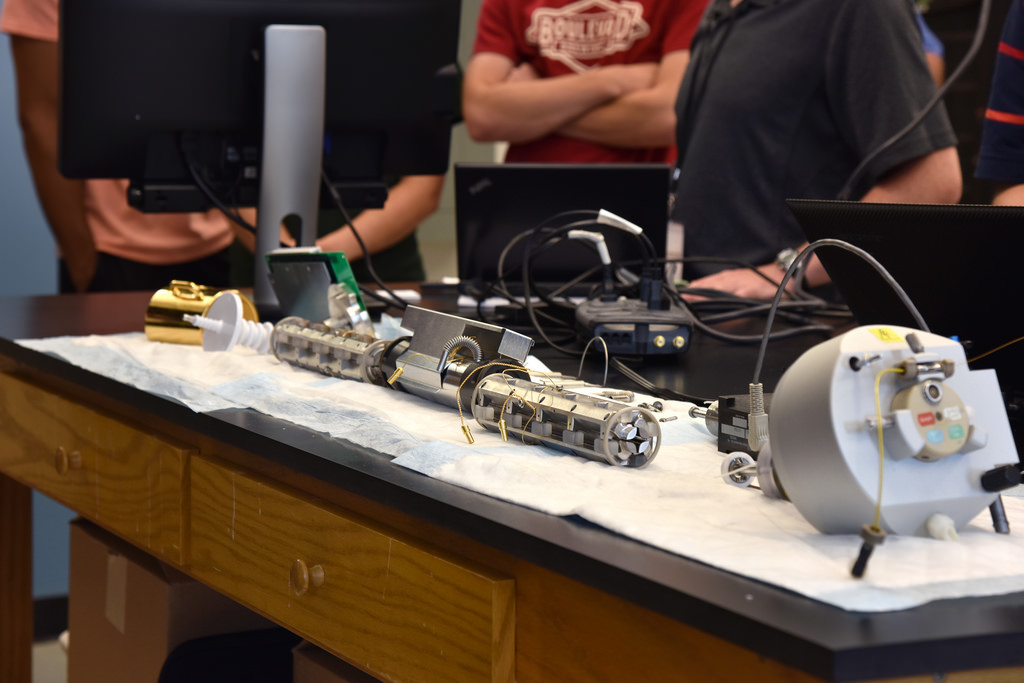Published on
Grand opening highlights specialty of large-scale metabolite profiling
By Phillip Sitter | Bond LSC

Dr. Zhentian Lei , assistant director and assistant research professor of the MU Metabolomics Center, provides an overview of an ultra high-pressure liquid chromatograph coupled to mass spectrometry for the large-scale profiling of metabolites at the University of Missouri Metabolomics Center open house on Aug. 12. | photo by Zivile Raskauskaite, Bond LSC
You might think you’ve entered the inside of a pinball machine for a moment when you enter lab 243 at the Bond Life Sciences Center.
But the wires and tubes strung around the room, connected to large instruments that produce sounds of whirring fans, humming motors and hissing pumps, are just part of the University of Missouri’s newest core facility, the MU Metabolomics Center.
At its grand opening and open house Friday, August 12, there was even a counter-top half-pipe with metal ball bearings to shoot down it as a demonstration of time of flight mass spectrometry.
This new center will serve as home of high-tech chemical analysis services that scientists in Bond LSC, across campus and the country can use to better understand the organisms they work with on a molecular level.

Lloyd Sumner, director of the MU Metabolomics Center, and Assistant Professor Ruthie Angelovici discuss the use of NMR for metabolite identification during the University of Missouri Metabolomics Center open house on Aug. 12. | photo by Zivile Raskauskaite, Bond LSC
“We have a series of experiments that allow us to profile hundreds to thousands of different metabolites, and that gives people a large-scale, high resolution biochemical traits for whatever they’re looking at, whether it be plants, microbes or animals,” explained Lloyd Sumner, director of the center. “That is useful in understanding what is happening in response to stresses, disease, drug treatment or pest/pathogen interactions that occur in nature.”
Metabolites are the building blocks and energy sources that fuel your metabolism. In your body, what you eat and drink is processed and yields small molecules that are ready to become raw chemical material for construction processes and energy to fuel these processes, like energy stored in the form of fats and lipids, amino acids for the construction of proteins and enzymes. Metabolite are essentially the raw materials.
In order to be studied, complex metabolite mixtures are separated and observed as individual, uniquely identifiable molecules.
This separation can be accomplished in a couple different ways.
“We have instruments that couple chromatography with mass spectrometry. We use that for comparative profiling. Some of the instruments utilize gas chromatography, some of the instruments use liquid chromatography. Chromatography is the technology used to separate these complex mixtures into its individual components. Once we have the mixture’s components separated, we weigh them and that gives us an idea of their identification,” Sumner explained.

These internal components of a triple quadrupole mass spectrometry are used for explaining how the instrument helps identify the metabolites within a sample during the University of Missouri Metabolomics Center open house on Aug. 12. | photo by Zivile Raskauskaite, Bond LSC
Mass spectrometry works by bombarding molecules with electrons. This bombardment process generates charged molecules that can also fragment into smaller, electrically-charged pieces. These charged pieces can then be “weighed,” or separated, according to their mass-to-charge ratio and identified.
“Something that we find a lot of the time is that we see metabolic differences, but we can’t always identify all of the metabolites associated with those differences. In those cases, we also use the gold standard for chemical identification of unknown molecules,” Sumner said of the nuclear magnetic resonance (NMR) spectrometer in the corner of the lab.

A person points at a 600 MHz Nuclear Magnetic Resonance Spectrometer used for metabolite identification during the University of Missouri Metabolomics Center open house on Aug. 12. | photo by Zivile Raskauskaite, Bond LSC
Placards warn people that when NMR produces a magnetic field 235,000 times stronger than the Earth’s — by comparison, a typical refrigerator magnet’s field is about 83 times as strong as the Earth’s.
Sumner explained that most people at Bond LSC won’t use the equipment directly themselves. The center’s Assistant Director Dr. Zhentian Lei and other staff will perform most analyses and training users to prepare, process and understand their data.
Sumner said “we train our core users to do their own sample preparation, data processing and data interpretation. Most of the equipment we have in here [cost] hundreds of thousands of dollars, and so we actually have staff that will do the data acquisition, and we try to make it more cost-effective for users by training them to prep their own samples and process their own data.”
The training workshop in metabolomics will be August 15 through 19. The training Monday through Thursday will be hands-on, and Friday will be a symposium day highlighting current metabolomics research. We will likely offer another training workshop in the Spring of 2017, and then annually thereafter.
For more information on using the MU Metabolomics Core or future training, email Director Lloyd Sumner at sumnerlw@missouri.edu or Assistant Director Zhentian Lei at leiz@missouri.edu.